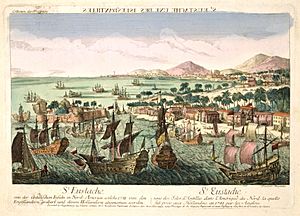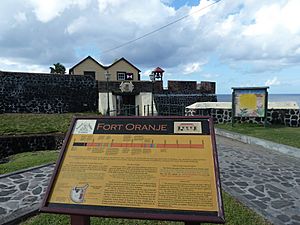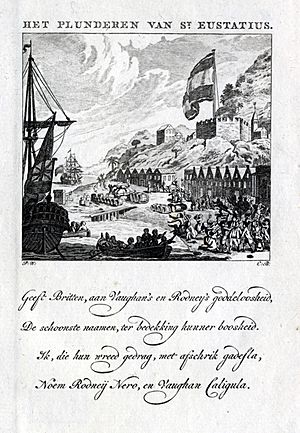Capture of Sint Eustatius facts for kids
The Capture of Sint Eustatius took place in February 1781 during the Fourth Anglo-Dutch War when British army and naval forces under Lieutenant-General Sir John Vaughan and Admiral George Rodney seized the Dutch-owned Caribbean island of Sint Eustatius. The capture was controversial in Britain, as it was alleged that Vaughan and Rodney had used the opportunity to enrich themselves and had neglected more important military duties. The island was subsequently taken by Dutch-allied French forces in late 1781, ending the British occupation.
Background
St. Eustatius, a Dutch-controlled island in the West Indies, was an entrepot that operated as a major trading centre despite its relatively small size. During the American War of Independence it assumed increased importance, because a British blockade made it difficult to transport supplies directly across the Atlantic Ocean to US ports. St. Eustatius became a crucial source of supplies, and its harbour was filled with American trading ships. Its importance increased further following France's entry into the war in 1778 as it was used to help supply the French West Indian islands. It is estimated that one half of all the American Revolutionary military supplies were trans-shipped through St. Eustatius. Its merchant networks – Dutch, but also Jewish, many of whom were St. Eustatius residents – were key to the military supplies and goods being shipped to the revolutionary forces. US-European communications were directed through St. Eustatius. In 1776, St. Eustatius, hence the Dutch, were the first to recognize the American Revolutionary government when the US brig, Andrew Doria, fired thirteen guns announcing their arrival. The Andrew Doria was saluted with an eleven gun response from Fort Orange. The Andrew Doria arrived to purchase military supplies on St. Eustatius and to present to the Dutch governor a copy of the US Declaration of Independence. An earlier copy of the Declaration had been captured by a British naval ship. The British were confused by the papers wrapped around the declaration, which they thought were a secret cypher. The papers were written in Yiddish for a merchant in Holland.
St. Eustatius's role in supplying Britain's enemies provoked anger amongst British leaders. Rodney alleged that goods brought out on British convoys had then been sold, through St. Eustatius, to the rebels. It seems to have fuelled a hatred for this island especially with Rodney who vowed to "bring this Nest of Villains to condign Punishment: they deserve scourging and they shall be scourged." He had already singled out several individuals on St. Eustatius who were instrumental in aiding the enemy, such as "... Mr Smith in the House of Jones – they cannot be too soon taken care of – they are notorious in the cause of America and France ..." Following the outbreak of war between the Dutch Republic and Britain in December 1780, orders were sent from London to seize the island. The British were assisted by the fact that the news of the war's outbreak had not yet reached St. Eustatius.
Capture
A British expedition of 3,000 troops sailed from Saint Lucia on 30 January 1781. Rodney left behind ships to monitor the French on Martinique. He also sent Samuel Hood ahead to stop any merchant ships escaping from the harbour. The main force arrived off St. Eustatius on 3 February. Rodney's ships took up position to neutralise any shore batteries. Two or three shots were fired from the only Dutch warship on the roadstead, the frigate Mars under Captain Count Van Bijland. Instead of disembarking the troops and launching an immediate assault, Rodney sent a message to Governor Johannes de Graaff suggesting that he surrender to avoid bloodshed. De Graaff agreed to the proposal and surrendered. De Graaff had ten guns in Fort Orange and sixty soldiers. Rodney had over 1,000 guns on his ships. By the following day the nearby islands of Saint Martin and Saba had also surrendered.
There was a brief exchange of fire when two of the British ships shot at the Mars and Van Bijland answered with his cannons. Rodney reprimanded the captains responsible for this lack of discipline.
The only battle occurred near Sombrero. Rodney found out that a convoy of thirty richly loaded Dutch merchant ships had just sailed off for the motherland less than two days before his arrival, protected only by a single man-of-war. He sent three warships after them, and they quickly caught up with the convoy. The lone Dutch man-of-war was no match for the three British ships and, after a fierce 30-minute pounding, the mortally wounded commander, Rear-Admiral Willem Krul, while dying, ordered his captain to lower the flag. Eight of the Dutch crew were killed. Krul was taken back to St. Eustatius where he was buried with full honours.
The crews of all Dutch ships taken at St. Eustatius and also those of Krul's convoy were stripped of all their possessions and taken to St. Kitts, where they were imprisoned- "with hardly anything more than the most necessary clothes."




